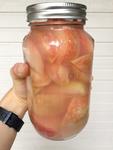Fermented Fruit Recipe- How To Eat FODMAPs with SIBO
What are FODMAPs?
FODMAP stands for "fermentable oligo-, di-, mono-saccharides and polyols" which are simple, short-chain carbohydrates and sugar alcohols. These carbohydrates tend to resist digestion and end up feeding our microbiota (the bacteria in our colon and intestines), but in some individuals, these easy to ferment carbohydrates can cause distressful symptoms such as bloating, pain, nausea and disturbed bowel habit (diarrhea and/or constipation), especially in those with IBS. (1)
You would more likely recognize these common types of FODMAPs:
Fructose: A simple sugar found in fruit but also in table sugar and most processed sugars.
Lactose: Found in dairy products.
Fructans: Found in many foods, including grains like wheat, spelt, rye, and barley.
Galactans: Found in large amounts in legumes.
Polyols: Sugar alcohols used as sweeteners (xylitol, sorbitol, maltitol, and mannitol) and also found in some fruits and vegetables.
Enter Wise Tradition: Fermentation
Fermentation seems to always be the answer to poor digestion. In the GAPS (Gut and Psychology and Physiology Syndrome) community, meat stocks and brines are the cure-alls. These superfoods are the ultimate food as medicine especially when taken at the proper dosages and in proper timing.
Fermented foods take time and much love to create them, but that seems to be part of the cure. Taking time to tend to your body by investing in quality food and cultivation of nutrients is a large part of the mindfulness and connection to food that we have been missing. Every time I go through a grocery store I am reminded of this disconnect. But, when I visit a farm stand, my belly and heart warm with joy.
Navigating FODMAPs with SIBO
Part of the sadness that comes with having SIBO (Small Intestine Bacterial Overgrowth) or any digestive, skin, or mood issues, is when you have to finally stop eating something you love once you figure out that food you love isn’t helping you, or actually causing some of your distress. It is the worst when you read the list of FODMAP foods to avoid and you just want to cry because you love all of the foods.
I’ve realized personally and with my clients that what one person is sensitive to with SIBO another person might not be, so these lists are really guides.
There are also strategies to maneuver FODMAPs at different stages of your healing journey. Initially, it might be most wise to eliminate high FODMAPs, but eventually, you will want to reintroduce some of these nutrient-dense foods because they also help support the health of the colon.
During reintroductions, using techniques like fermentation plus finding your threshold of the quantity of higher FODMAP foods is key.
I wanted to offer a guide that might be helpful for those struggling with digesting fruit sugars, like me. If this works for you please tell me in the comments! If it doesn’t, I’d love to hear more about your experience and you can comment or email me questions.
Fermented Fruit
The art of fermentation helps to pre-digest the foods we eat creating more beneficial bacteria, enzymes, and even creating more bio-available vitamins. In the case of FODMAP fruits, fermentation can help digest the hard to digest sugars that might ferment in your gut. When introducing these foods, it is best to start with drinking the brine (fermented liquid) in small doses until tolerated before eating the fruit.
Fermented Fruit
Natalie Earle | August 2019
Servings: 1 quart of fruit
Ingredients:
- Fruit of choice, sliced to fill 1 quart mason jar
- about 1 quart of Coconut water kefir
Instructions:
- Add all the fruit to your cleaned jar
- Cover the fruit with Coconut Water Kefir
- Use a weight to keep fruit submerged.
- Ferment at room temperature out of direct sunlight for 24-48 hours, depending on how much fruit sugars you want pre-digested.
- After fermentation, remove fruit and store in refrigerator up to 3 days, or freeze to use in smoothies or baked recipes. *Note: you can drink the coconut water kefir or reuse it one more time to ferment a second batch of fruit. After that second batch, it is best to drink it up!




I talk all about digestion in an earlier blog post, but in today's post, I am focussing on a common ailment that often contributes to acne. A frequent symptom of poor digestion in the small intestines is SIBO or Small Intestine Bacterial Overgrowth.